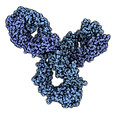Research overview
“What I cannot create, I do not understand”
– Richard Feynman
Our research focuses on understanding how tumors evade recognition by the immune system. Tumors secrete an arsenal of inhibitory factors that allow them to "hide in plain sight" in the face of a mounting immune response. One of our primary strategies is to visualize, on the molecular level, how these immunosuppresive proteins inactivate T cells in the tumor microenvironment. This structural information then provides us with high-resolution blueprints that can be used to guide the engineering of potent immunotherapy drugs. To accomplish these goals, our team uses a multidisciplinary approach that incorporates directed evolution, computational modeling, structural biology (x-ray crystallography and cryoEM), and cellular signaling assays.
Ongoing projects include:
1) Enhancing T cell immunotherapy with synthetic modulators of Notch signaling
2) Mechanistic studies of T cell inhibition by the immune checkpoint receptor LAG3
3) Development of AI-based in silico screening methods to identify novel immunotherapy drug targets
Structural biology
Receptor signaling
Protein engineering
Novel therapeutics


wt
v2.0
[Ligand]
v1.0

Cellular receptor activation
Protein binding kinetics


